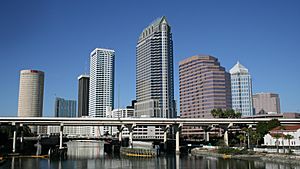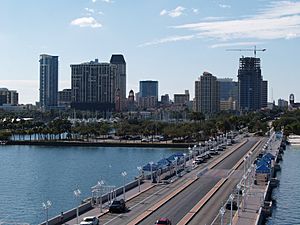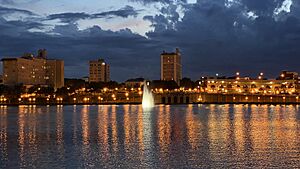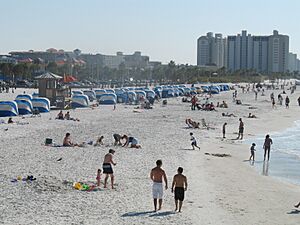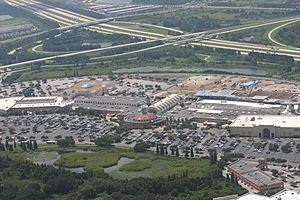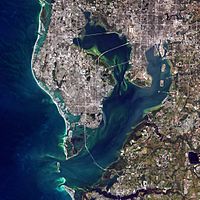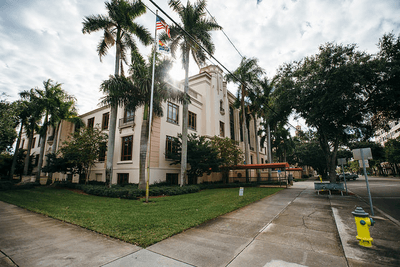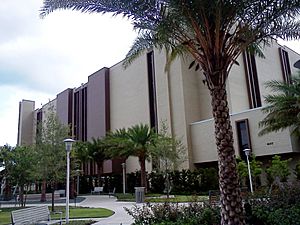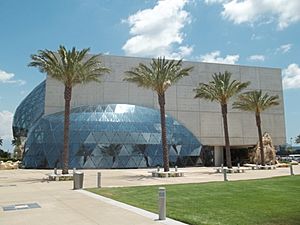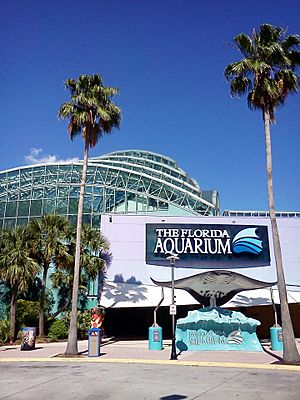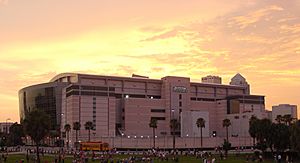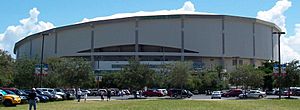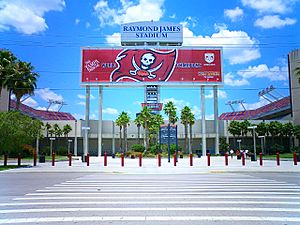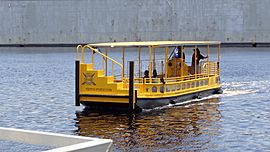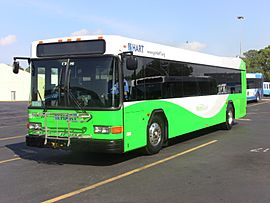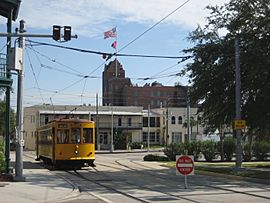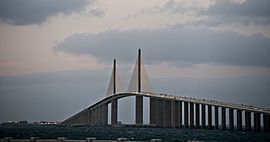Tampa Bay area facts for kids
Quick facts for kids
Tampa Bay area
Tampa–St. Petersburg–Clearwater MSA
|
|
|---|---|
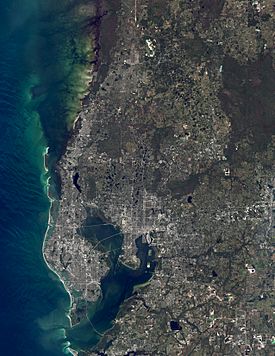
A natural color satellite image of the Tampa Bay Metropolitan Statistical Area. Composite image created from November 2019 imagery with NASA's Landsat 8 satellite.
|
|
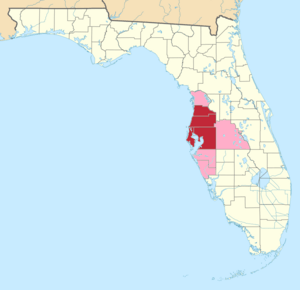
The Tampa–St. Petersburg–Clearwater Metropolitan Statistical Area (red) and other counties which are sometimes considered to be part of the Tampa Bay area.
|
|
| Country | United States |
| State | Florida |
| Largest city | Tampa |
| Other major cities | |
| Population
(2010)
|
2,783,469 |
| • Estimate
(2019)
|
3,194,831 |
| Ranked 18th in the US | |
| Time zone | UTC−05:00 (EST) |
| • Summer (DST) | UTC−04:00 (EDT) |
| Area code(s) | 813, 727, 352, 863 |
The Tampa Bay area is a big place on the west coast of Florida in the United States. It's named after Tampa Bay, a large body of water. The main cities here are Tampa, St. Petersburg, and Clearwater.
This area is the 18th largest metropolitan area in the United States. In 2020, about 3.1 million people lived here. The exact size of the Tampa Bay area can change depending on how it's defined.
The United States Census Bureau says the Tampa–St. Petersburg–Clearwater Metropolitan Statistical Area (MSA) includes four counties: Hernando, Hillsborough, Pasco, and Pinellas. Sometimes, other nearby counties like Citrus, Manatee, Sarasota, and Polk are also included. This wider area is sometimes called West Central Florida.
Exploring the Tampa Bay Area
The Tampa Bay MSA had 3,175,275 people living there in the 2020 United States census. The population has grown a lot over the years.
| Historical population | |||
|---|---|---|---|
| Census | Pop. | %± | |
| 1900 | 36,013 | — | |
| 1910 | 78,314 | 117.5% | |
| 1920 | 116,552 | 48.8% | |
| 1930 | 215,668 | 85.0% | |
| 1940 | 272,000 | 26.1% | |
| 1950 | 409,143 | 50.4% | |
| 1960 | 820,443 | 100.5% | |
| 1970 | 1,105,553 | 34.8% | |
| 1980 | 1,613,603 | 46.0% | |
| 1990 | 2,067,959 | 28.2% | |
| 2000 | 2,395,997 | 15.9% | |
| 2010 | 2,783,243 | 16.2% | |
| 2020 | 3,175,275 | 14.1% | |
| source: | |||
Many cities and towns make up the Tampa–St. Petersburg–Clearwater MSA. Here are some of the biggest ones:
Major Cities
These cities have more than 250,000 people:
Other Large Communities
These places have more than 100,000 people:
- Clearwater
- Lakeland
- Riverview (a census-designated place, or CDP)
- Brandon (CDP)
- Spring Hill (CDP)
There are also many other smaller cities and communities with over 10,000 people. Some examples include Largo, Dunedin, Plant City, and Tarpon Springs.
Who Lives Here?
The Tampa Bay area is home to a diverse group of people.
| Demographic | Percentage |
|---|---|
| White (Non-Hispanic/Latino) | 76.0% |
| Hispanic | 10.4% |
| Black | 10.4% |
| Asian/Pacific Islander | 2.4% |
The average age of people in Tampa Bay is about 41 years old.
| Age Group | Percentage |
|---|---|
| 0–17 years old | 22.0% |
| 18–34 years old | 19.6% |
| 35–54 years old | 27.3% |
| 55–64 years old | 11.6% |
| 65 and over | 19.4% |
Geography and Climate
The Tampa Bay area is located right next to Tampa Bay. Pinellas County and St. Petersburg are on a peninsula between Tampa Bay and the Gulf of Mexico. Much of Tampa city is also on a smaller peninsula.
Weather in Tampa Bay
The Tampa Bay area has a humid subtropical climate. This means it has hot, humid summers with daily thunderstorms. Winters are drier and mostly sunny. Springs are warm to hot with a dry season.
It rarely gets very cold here. Hard freezes, where temperatures drop below 28°F, are very unusual. The area is known for its tropical plants like coconut palms. High temperatures usually stay between 65°F and 95°F all year. Tampa's highest temperature ever recorded is 99°F.
Being close to the large bodies of water like the Gulf of Mexico and Tampa Bay helps keep temperatures mild. It also adds a lot of humidity to the air. Places further from the coast usually have bigger temperature changes.
| Climate data for Tampa, Florida (Tampa Int'l), 1981−2010 normals, extremes 1890−present | |||||||||||||
|---|---|---|---|---|---|---|---|---|---|---|---|---|---|
| Month | Jan | Feb | Mar | Apr | May | Jun | Jul | Aug | Sep | Oct | Nov | Dec | Year |
| Record high °F (°C) | 86 (30) |
88 (31) |
92 (33) |
93 (34) |
98 (37) |
99 (37) |
98 (37) |
98 (37) |
96 (36) |
95 (35) |
92 (33) |
86 (30) |
99 (37) |
| Mean maximum °F (°C) | 81.1 (27.3) |
82.3 (27.9) |
85.2 (29.6) |
88.2 (31.2) |
93.3 (34.1) |
94.8 (34.9) |
94.8 (34.9) |
94.4 (34.7) |
93.5 (34.2) |
90.8 (32.7) |
86.2 (30.1) |
82.4 (28.0) |
96.0 (35.6) |
| Mean daily maximum °F (°C) | 69.9 (21.1) |
72.5 (22.5) |
76.3 (24.6) |
81.0 (27.2) |
87.2 (30.7) |
89.6 (32.0) |
90.1 (32.3) |
90.2 (32.3) |
88.9 (31.6) |
84.3 (29.1) |
78.0 (25.6) |
72.0 (22.2) |
81.7 (27.6) |
| Daily mean °F (°C) | 60.8 (16.0) |
63.4 (17.4) |
67.3 (19.6) |
72.0 (22.2) |
78.4 (25.8) |
82.2 (27.9) |
83.0 (28.3) |
83.2 (28.4) |
81.7 (27.6) |
76.2 (24.6) |
69.1 (20.6) |
63.1 (17.3) |
73.4 (23.0) |
| Mean daily minimum °F (°C) | 51.6 (10.9) |
54.4 (12.4) |
58.2 (14.6) |
63.0 (17.2) |
69.7 (20.9) |
74.8 (23.8) |
75.9 (24.4) |
76.2 (24.6) |
74.5 (23.6) |
68.0 (20.0) |
60.3 (15.7) |
54.2 (12.3) |
65.1 (18.4) |
| Mean minimum °F (°C) | 32.6 (0.3) |
37.0 (2.8) |
41.4 (5.2) |
48.8 (9.3) |
59.6 (15.3) |
68.3 (20.2) |
70.8 (21.6) |
71.7 (22.1) |
67.5 (19.7) |
53.2 (11.8) |
44.6 (7.0) |
36.1 (2.3) |
30.2 (−1.0) |
| Record low °F (°C) | 21 (−6) |
22 (−6) |
29 (−2) |
38 (3) |
49 (9) |
53 (12) |
63 (17) |
66 (19) |
54 (12) |
40 (4) |
23 (−5) |
18 (−8) |
18 (−8) |
| Average rainfall inches (mm) | 2.23 (57) |
2.81 (71) |
3.03 (77) |
2.03 (52) |
2.10 (53) |
6.68 (170) |
7.07 (180) |
7.77 (197) |
6.30 (160) |
2.26 (57) |
1.55 (39) |
2.47 (63) |
46.30 (1,176) |
| Average rainy days (≥ 0.01 inch) | 6.8 | 6.6 | 6.6 | 4.9 | 5.5 | 12.7 | 15.9 | 16.0 | 12.2 | 6.5 | 5.1 | 5.8 | 104.6 |
| Average relative humidity (%) | 74.9 | 73.0 | 71.8 | 69.0 | 69.8 | 74.4 | 76.6 | 78.4 | 77.6 | 74.2 | 75.0 | 75.0 | 74.1 |
| Mean monthly sunshine hours | 199.9 | 202.7 | 267.5 | 299.1 | 314.5 | 277.8 | 265.3 | 249.5 | 223.0 | 233.9 | 201.7 | 191.6 | 2,926.5 |
| Percent possible sunshine | 61 | 65 | 72 | 78 | 75 | 67 | 62 | 61 | 60 | 66 | 62 | 60 | 66 |
| Source: NOAA (relative humidity and sun 1961−1990) Weather Channel | |||||||||||||
Economy and Jobs
The Tampa Bay area has a strong economy with many different types of jobs.
As of 2019, here are some of the largest employers:
| Employer | Employees | Industry |
|---|---|---|
| BayCare Health System | 28,400 | Healthcare |
| Publix Super Markets | 25,989 | Grocery |
| Hillsborough County School District | 25,173 | Education |
| HCA West Florida Division | 18,832 | Healthcare |
| MacDill Air Force Base | 18,000 | Military |
Important Industries
Many businesses in Tampa Bay work in financial services and information technology. This area is part of the Florida High Tech Corridor. This corridor helps grow high-tech industries across Central Florida.
Some big financial companies here include Bank of America, JPMorgan Chase, and Wells Fargo. Many insurance companies like Progressive Insurance and State Farm also have offices here.
Research and Education
Academic research is very important for new technology. The University of South Florida has research centers that work on exciting things. For example, they research nanotechnology for drug delivery and even ways to turn sunlight into electricity.
The University of Tampa is another historic university located in Downtown Tampa.
Military Presence
Tampa Bay is home to three major military bases. These are MacDill Air Force Base, Coast Guard Air Station Clearwater, and Coast Guard Station St. Petersburg. MacDill Air Force Base is home to important commands like United States Central Command (USCENTCOM) and United States Special Operations Command (USSOCOM). These commands help direct military operations and special forces.
Education
Kids in the Tampa Bay area go to schools run by their local county school districts.
There are also many colleges and universities. The main campus of the University of South Florida is in Tampa. Other four-year colleges include Eckerd College in St. Petersburg and the University of Tampa.
For those interested in law, there are two law schools: Stetson University College of Law and Thomas M. Cooley Law School. Community colleges like Hillsborough Community College and St. Petersburg College also serve the area.
Culture and Arts
The Tampa Bay area has many great art museums. Historic neighborhoods like Ybor City and Hyde Park in Tampa have beautiful old buildings.
You can find fresh seafood and local produce in restaurants and at weekly farmers' markets. The area is also known for its influence on heavy metal music, especially death metal.
Arts and culture bring a lot of money to Tampa Bay. In one year, cultural places like museums and theaters added over $521 million to the economy. They also supported about 7,800 jobs.
Museums to Visit
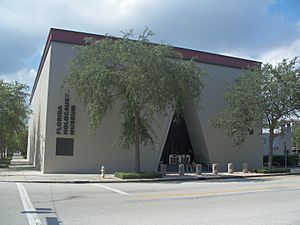
- Museum of Fine Arts in St. Petersburg
- Salvador Dalí Museum in St. Petersburg, featuring art by the famous artist
- Florida Holocaust Museum in St. Petersburg
- Tampa Museum of Art in Tampa
- Museum of Science and Industry (MOSI) in Tampa
- Tampa Bay Automobile Museum in Pinellas Park
- Tampa Bay History Center
- Ybor City Museum State Park
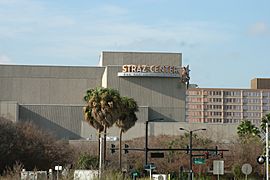
Places for Shows
- Straz Center for the Performing Arts in Tampa
- Ruth Eckerd Hall in Clearwater
- Mahaffey Theater in St. Petersburg
Fun Cultural Events
- Gasparilla Pirate Festival: A big pirate-themed festival every January in Tampa.
- Florida State Fair: Held every February in Tampa.
- Florida Strawberry Festival: Celebrates strawberries every March in Plant City.
- Clearwater Jazz Holiday: A music festival every October in Clearwater.
- Guavaween: A Latin-inspired Halloween party in Ybor City.
Recreation and Fun
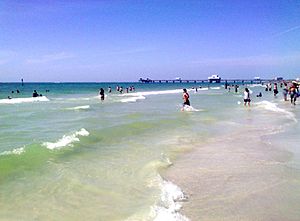
The Tampa Bay area is famous for its beautiful beaches. The warm, blue waters of the Gulf of Mexico and nearly 70 miles of barrier islands attract visitors from all over the world. Some beaches, like Fort De Soto's North Beach and Caladesi Island, have been named among America's best.
Besides beaches, there are many golf courses, tennis courts, and pools. The nightlife in Ybor City, downtown St. Petersburg, and along the beaches is very lively.
Theme Parks
- Adventure Island: A water park in Tampa.
- Busch Gardens: A theme park with rides and animals in Tampa.
- Dinosaur World: A park with dinosaur models in Plant City.
- Weeki Wachee Springs: Famous for its mermaid shows.
- Legoland Florida: A Lego-themed park in Winter Haven.
Zoos and Aquariums
- Lowry Park Zoo in Tampa.
- Florida Aquarium in Tampa.
- Clearwater Marine Aquarium in Clearwater, known for rescuing marine animals.
- Suncoast Seabird Sanctuary in Indian Shores.
Gardens and Parks
- Florida Botanical Gardens in Largo.
- Sunken Gardens in St. Petersburg.
- USF Botanical Gardens in Tampa.
The area has many state, county, and city parks. Hillsborough River State Park is one of Florida's oldest state parks. The Pinellas Trail is a 37-mile path for running and biking. The Skyway Fishing Pier State Park is the world's largest fishing pier. The shallow waters and mangrove islands are great for kayaking. Many natural and artificial reefs are popular for fishing and scuba diving.
Sports in Tampa Bay
The Tampa Bay Area is home to three major professional sports teams:
- The Tampa Bay Buccaneers (NFL - American football)
- The Tampa Bay Lightning (NHL - ice hockey)
- The Tampa Bay Rays (MLB - baseball)
There are also many minor-league and college sports teams.
Baseball Spring Training
Many Major League Baseball teams come to the Tampa Bay area for spring training games in March. This is a favorite activity for locals and tourists.
- The New York Yankees train in Tampa.
- The Philadelphia Phillies train in Clearwater.
- The Toronto Blue Jays train in Dunedin.
- The Pittsburgh Pirates train in Bradenton.
- The Detroit Tigers train in Lakeland.
Minor League Baseball
The area also has several Minor League baseball teams:
- The Tampa Tarpons
- The Clearwater Threshers
- The Dunedin Blue Jays
- The Bradenton Marauders
- The Lakeland Flying Tigers
Basketball
The Tampa Bay area does not have an NBA team. However, the Toronto Raptors played their home games here temporarily during the 2020–21 season due to travel rules.
Major Sporting Events
Tampa Bay has hosted many big sports events:
- Five Super Bowls (American football championship) have been held in Tampa.
- The 2008 MLB World Series had games in St. Petersburg.
- The NHL All-Star Game was held in Tampa in 1999 and 2018.
- Several Stanley Cup Finals games have been played in Tampa.
- The NCAA football Outback Bowl and Gasparilla Bowl are held every year.
- The 2017 College Football Playoff National Championship was held here.
- Various NCAA basketball tournaments have taken place in Tampa.
Getting Around Tampa Bay
By Air
Tampa International Airport is the biggest airport in the region. It serves over 17 million passengers each year. St. Pete–Clearwater International Airport also offers commercial flights. There are also many smaller airports for private planes.
By Train
Amtrak offers passenger train service from Union Station in Tampa. CSX provides freight train service for the whole region.
By Water
The Cross-Bay Ferry connects downtown Tampa to downtown St. Petersburg. The Pirate Water Taxi offers rides along the waterways in downtown Tampa.
Public Transportation
Bus services are available in Hillsborough, Pinellas, Pasco, and Hernando counties. There's also a streetcar that runs between Downtown Tampa and Ybor City. A Bus rapid transit system called MetroRapid connects Downtown Tampa to the University of South Florida.
The Tampa Bay Area Regional Transportation Authority (TBARTA) works to create more transportation options for the whole region.
Roads and Highways
The Tampa Bay area has several major highways:
 Interstate 4
Interstate 4 Interstate 75
Interstate 75 Interstate 175
Interstate 175 Interstate 275
Interstate 275 Interstate 375
Interstate 375
Other important roads include the Lee Roy Selmon Expressway and the Veterans Expressway. These are toll roads that help people travel around the area.
The Courtney Campbell Causeway, Howard Frankland Bridge, and Gandy Bridge connect Pinellas County to Hillsborough County across the bay. The Sunshine Skyway Bridge is a famous bridge that connects Pinellas County to Bradenton and other southern areas.
Images for kids
See also
 In Spanish: Área de la Bahía de Tampa para niños
In Spanish: Área de la Bahía de Tampa para niños


